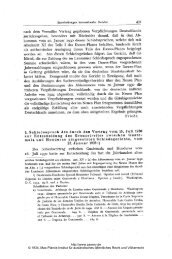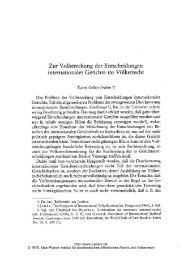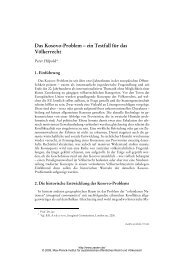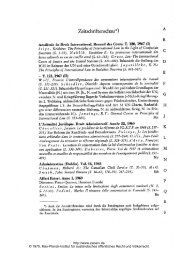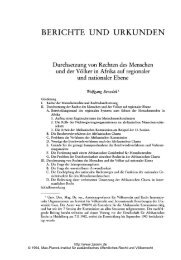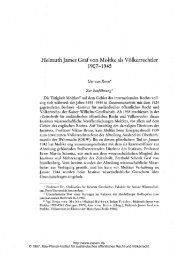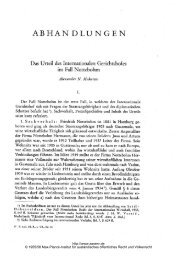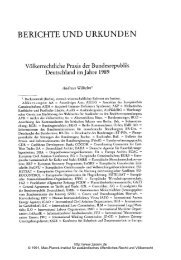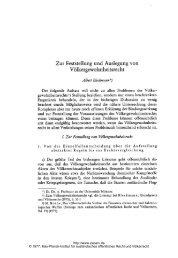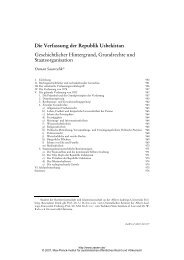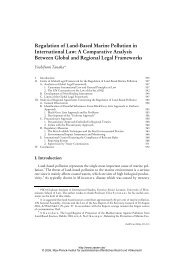838 Rao<strong>and</strong> <strong>the</strong> States, <strong>and</strong>, subject to <strong>the</strong> o<strong>the</strong>r provisions <strong>of</strong> Chapter I<strong>of</strong> Part XIV, regulate<strong>the</strong> recruitment, <strong>and</strong> <strong>the</strong> conditions <strong>of</strong> service <strong>of</strong> persons appointed, to anysuch service.Under article 309, <strong>the</strong> recruitment <strong>and</strong> conditions <strong>of</strong> service <strong>of</strong> <strong>the</strong>members <strong>of</strong> <strong>the</strong> subordinate judiciary are to be regulated by <strong>the</strong> Acts <strong>of</strong> <strong>the</strong> appropriateLegislature, <strong>and</strong>, pending such legislation, <strong>the</strong> President <strong>and</strong> <strong>the</strong> Governoror <strong>the</strong>ir nominees, as <strong>the</strong> casemay be, are empowered to make rules regulating<strong>the</strong>ir recruitment <strong>and</strong> <strong>the</strong> conditions <strong>of</strong> service.In 1991, <strong>the</strong> Supreme Court gave certain directions to improve <strong>the</strong> service con-based on <strong>the</strong> recom-ditions <strong>of</strong> <strong>the</strong> members <strong>of</strong> <strong>the</strong> subordinate judiciary largelymendations <strong>of</strong> <strong>the</strong> Law Commission <strong>of</strong> India made in its 14th Report prepared in1958.160 Upon filing <strong>of</strong> review petitions, <strong>the</strong> Court considered <strong>the</strong> matter again in1993 <strong>and</strong> gave modified directions.161 The Union <strong>of</strong> India contended that <strong>the</strong> serviceconditions <strong>of</strong> <strong>the</strong> subordinate judiciary are a matter <strong>of</strong> policy <strong>and</strong> <strong>the</strong> authorityto prescribe <strong>the</strong>m is vested in <strong>the</strong> Legislature <strong>and</strong> t*he Executive, that <strong>the</strong> implementation<strong>of</strong> <strong>the</strong> directions given by <strong>the</strong> Court would place a very heavy financialburden on <strong>the</strong> public exchequer <strong>and</strong> might generate. similar dem<strong>and</strong>s by <strong>the</strong>o<strong>the</strong>r services, etc. Rejecting <strong>the</strong> arguments, <strong>the</strong> Court observed that <strong>the</strong> members<strong>of</strong> <strong>the</strong> judiciary are comparable to <strong>the</strong> Council <strong>of</strong> Ministers <strong>and</strong> legislators <strong>and</strong>, accordingly,st<strong>and</strong> on a higher footing than <strong>the</strong> members <strong>of</strong> <strong>the</strong> o<strong>the</strong>r services, that<strong>the</strong> society has a stake in ensuring <strong>the</strong>. independence <strong>of</strong> <strong>the</strong> judiciary <strong>and</strong>, <strong>the</strong>refore,<strong>the</strong> judges cannot be kept in want, that, though article 309 only gives powerto <strong>the</strong> Executive <strong>and</strong> <strong>the</strong> Legislature to prescribe <strong>the</strong> service conditions <strong>of</strong> <strong>the</strong> judiciary,it would be in <strong>the</strong> interests <strong>of</strong> <strong>the</strong> independence <strong>of</strong> <strong>the</strong> judiciary to allow<strong>the</strong> judiciary to play a role in this behalf, <strong>and</strong> that, if <strong>the</strong> Executive <strong>and</strong> <strong>the</strong> Legislaturealone are allowed to deal with <strong>the</strong> matter by virtue <strong>of</strong> article 309, <strong>the</strong>y mayuse that power "to turn <strong>and</strong> twist <strong>the</strong> tail Of <strong>the</strong> judiciary". The Court <strong>the</strong>n proceededto give directions related to setting up <strong>of</strong> All India Judicial Service, raising<strong>of</strong> superannuation age <strong>of</strong> judicial <strong>of</strong>ficers up to 60 years, uniformity in payscales,grant <strong>of</strong> residence-cum-library allowance, provision <strong>of</strong> conveyance, in-servicetraining, etc.; it specified time-limits for implementing <strong>the</strong>se directions. The view<strong>of</strong> <strong>the</strong> Court that article 309 can be breached by it in <strong>the</strong> interests <strong>of</strong> <strong>the</strong> independence<strong>of</strong> <strong>the</strong> judiciary is a dangerous proposition <strong>and</strong> raises <strong>the</strong> question whe<strong>the</strong>r<strong>the</strong> Court sees its role as <strong>the</strong> protector <strong>of</strong> judicial independenceConstitution <strong>of</strong> India. The Court obviously made up itsra<strong>the</strong>r than <strong>of</strong> <strong>the</strong>mind that <strong>the</strong> lot <strong>of</strong> <strong>the</strong>judicial <strong>of</strong>ficers needed to be improved<strong>and</strong> laid downfanciful <strong>the</strong>ories in support<strong>the</strong>re<strong>of</strong>.160All India judges' Association v. Union <strong>of</strong> India, AIR 1992 SC 165.161All India Judges'Association v. Union <strong>of</strong> India, AIR 1993 SC 2493.http://www.zaoerv.de© 1998, Max-Planck-Institut für ausländisches öffentliches Recht und Völkerrecht
containinginsertedUse <strong>and</strong> <strong>Abuse</strong> <strong>of</strong> <strong>the</strong> <strong>Indian</strong> Constitution 839In K Veeraswami v.(iii) Criminal cases against judgesUnion <strong>of</strong> India,162 <strong>the</strong> Supreme Court, while declaring that<strong>the</strong> Prevention <strong>of</strong> Corruption Act, 1947, applied even to <strong>the</strong> judges <strong>of</strong> <strong>the</strong> SupremeCourt <strong>and</strong> <strong>of</strong> <strong>the</strong> High Courts, held that, in order toprotect <strong>the</strong> independence<strong>of</strong> <strong>the</strong> judiciary, it was'essential that no criminal case shall be registeredunder section 154 <strong>of</strong> <strong>the</strong> Code <strong>of</strong> Criminal Procedure against such a judge, unless<strong>the</strong> QJ1 is consulted <strong>and</strong> he assents to such an action being taken. The Court observedthat <strong>the</strong> apprehension that <strong>the</strong> Executive, being <strong>the</strong> largest litigant, is likelyto misuse <strong>the</strong> power to prosecute <strong>the</strong> judges seems to be "not unjustified or unfounded".The need for obtaining <strong>the</strong> assent <strong>of</strong> <strong>the</strong> QJI was thus introduced into<strong>the</strong> Act not by Parliament but by <strong>the</strong> Supreme Court; it amounted to enacting anew law outside <strong>the</strong> scope <strong>of</strong> <strong>the</strong> Act.163If <strong>the</strong> Supreme- Court is correct in assuming that <strong>the</strong> o<strong>the</strong>r organs <strong>of</strong> <strong>the</strong> Statecannot be trusted when <strong>the</strong> matter involved is one <strong>of</strong> judicial independence itcould well lead to a situation in which one could have misgivings as to how <strong>the</strong>QJI would act in a case where one <strong>of</strong> his own colleagues is sought to be prosecutedon charges <strong>of</strong> corruption. Decisions in such matters, needless to say, have tobe based on "trust" <strong>and</strong> not "mistrust".(iv) Belittling administrative tribunalsIn L. Cb<strong>and</strong>ra Kumar v. Union <strong>of</strong> India,164 <strong>the</strong> Supreme Court swiped at arti-in <strong>the</strong> Constitution with effectcles 323A <strong>and</strong> 323B <strong>of</strong> <strong>the</strong> Constitution-from 3 January 1977 -enabling provisions for <strong>the</strong> establishment <strong>of</strong> administrativetribunals. Pursuant to article 323A, Parliament enacted <strong>the</strong> AdministrativeTribunals Act, 1985, for <strong>the</strong> resolution <strong>of</strong> service disputes <strong>and</strong> for <strong>the</strong> exclusion<strong>of</strong> <strong>the</strong> jurisdiction <strong>of</strong> all courts, except <strong>the</strong> jurisdiction <strong>of</strong> <strong>the</strong> SupremeCourt under articles 32 <strong>and</strong> 136 <strong>of</strong> <strong>the</strong> Constitution. Article 323A was inserted in<strong>the</strong> Constitution by <strong>the</strong> Constitution (Forty-second Amendment) Act, 1976, toprovide for <strong>the</strong> expeditious disposal <strong>of</strong> service disputes by tribunals which are notbound by strict rules <strong>of</strong> procedure or <strong>of</strong> evidence.The validity <strong>of</strong> <strong>the</strong> aforesaid Act was first considered by <strong>the</strong> Supreme Court in1985 in <strong>the</strong> Sampatb Kumar case,165 wherein a 5-Judge Constitution Bench directed<strong>the</strong> carrying out <strong>of</strong> certain measures with a view to ensuring <strong>the</strong> functioning<strong>of</strong> <strong>the</strong> Central Administrative Tribunal along constitutionally sound principles.The Act was amended by Act 19 <strong>of</strong> 1986 to bring about <strong>the</strong> changes prescribedby <strong>the</strong> Court. Following <strong>the</strong> order <strong>of</strong> <strong>the</strong> Supreme Court in 1987,166 <strong>the</strong>Act was again amended. It was felt,<strong>the</strong>reafter, that <strong>the</strong> constitutional validity <strong>of</strong>162(1991) 3 SCC 655.163 See also <strong>the</strong> dissenting judgment <strong>of</strong> Ve r m a, J., in Veeraswamy case, (1991) 3 SCC 655, 727.164Supra note.29.165Sampatb Kumar v. Union <strong>of</strong> India, (1985) 4 SCC 458.166(1987) 1 SCC 124.http://www.zaoerv.de© 1998, Max-Planck-Institut für ausländisches öffentliches Recht und Völkerrecht



